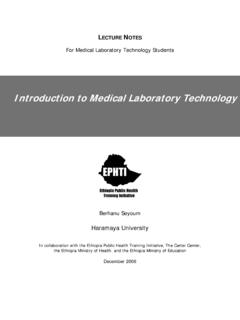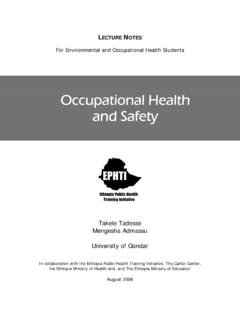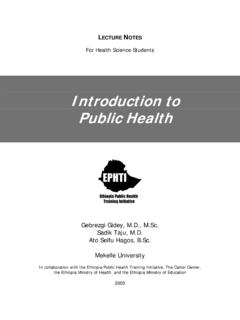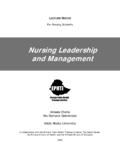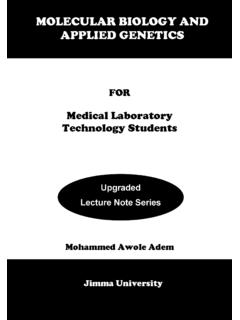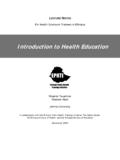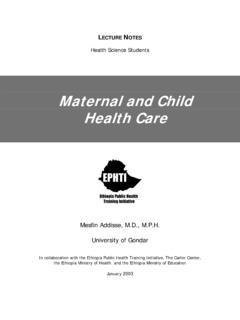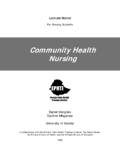Transcription of Lecture Notes on reproductive health - cartercenter.org
1 reproductive health . FOR. health Science Students Lecture Note Feleke Worku (MD). Samuel Gebresilassie (MD). University of Gondar reproductive health . For health Science Students Lecture Note Feleke Worku (MD) Lecturer Samuel Gebresilassie (MD). Associate Professor of Gynecology and Obstetrics 2008. In collaboration with The Carter Canter (EPHTI) and The Federal Democratic Republic of Ethiopia Ministry of Education and Ministry of health University of Gondar PREFACE. This Lecture note Lecture note in reproductive health for health science students is prepared in accordance with the current curriculum, which we think will be of help to meet the millennium development goals in the health perspective, which is broader in scope and extensive in contents than the already existing maternal on child health . It will help students and other readers to understand the current reproductive health understandings. Starting with the definition, we have gone through its components.
2 Each component was dealt with extensively as a chapter. Emphasis was given to the service provision and challenges and on how to overcome the challenges which most of the time is not easily available and accessible for the students. In each reproductive health component, we tried to address important national and international up-dated figures and evidence based and practical reproductive health and related issues. The authors i ACKNOWLEDGEMENT. We would like to express our deepest gratitude to The Carter Center, Ethiopian Public health Training Initiative to take the initiative and sponsor the development of this Lecture note. We would like to thank the internal reviewers of the University of Gondar staff, W/t Alemtsehay Mekonnen from the Department of Midwifery and Dr. Desalegn Tigabu, Department of epidemiology. We would like to express our appreciation to the external reviewers: ACCESS JHPIEGO for the excellent comments they gave us. We would like to thank the reviewers of inter institution: Dr.
3 Nega Jimma University Dr. Million Debub University Ato Araya Mekelle University Ato Anteneh Haremaya University Finally, we thank all individuals and institutions who helped us in making this invaluable material to come to a reality. ii Table of content Preface ..i Table of Content .. iii List of Table .. vii List of Figures .. viii CHAPRTER 1: Introduction to reproductive 1. 1. Definition and 1. Historical development of the concept .. 2. Development of reproductive health .. 8. Magnitude of reproductive health Problem .. 10. Components of reproductive health .. 12. 2. reproductive health indicators .. 13. CRITERIA FOR SELECTING 14. Sources of data .. 18. reproductive health Indicators for Global 19. 3. Gender and reproductive 24. Gender differences: .. 29. 4. reproductive health AND DEFINING TARGET. POPULATION .. 34. CHAPRTER 2: Material health .. 40. 1. Introduction .. 40. iii 2. The Safe Motherhood Initiative .. 42. Essential Services for Safe 43.
4 Causes of Maternal Mortality and Morbidity .. 49. Maternal health services .. 61. Estimation of maternal 91. CHAPRTER 3: Abortion .. 108. Public health Importance of Abortion .. 110. Why Women Find Themselves with Unwanted Pregnancy? .. 113. Why does induced Abortion Occur? .. 115. Legislation and 118. Inadequate services .. 119. What can be done about unwanted pregnancies and unsafe abortions?.. 120. Grounds on Which Abortion is Permitted, revised abortion law of Ethiopia, (House of Parliament, 2005) .. 125. CHAPRTER 4: Family Planning .. 127. and Rationale for Family Planning Programs in Developing Countries .. 129. Family Planning methods .. 133. Fertility Trends and Contraceptive 135. Men's Attitude towards FP .. 138. iv Fertility among Different Groups .. 138. Counseling in Family 139. Trends in Contraceptive Use in 144. Family Planning Delivery Strategies .. 145. Reasons for Not Using Contraceptives .. 148. CHAPRTER 5: Sexually Transmitted infections.
5 151. 151. Classification of 158. Traditional Approaches to STI 160. The STI Syndromes and the Syndromic Approach to Case Management .. 161. Why Invest in STI Prevention and Control Now? ..165. STI Control 166. Obstacles to Provision of Services for STI. Control .. 169. CHAPRTER 6: HIVIDS and reproductive health .. 173. 173. Modes of Transmission of HIV .. 179. CHAPRTER 7: Harmful Traditional Practices .. 219. Introduction .. 219. Violence against Women .. 222. Female genital mutilation (FGM).. 236. Early Marriage (EM): .. 239. v CHAPRTER 8: Adolescent reproductive 246. Global Youth 248. reproductive health Risks and consequences for adolescents .. 256. Causes for early unprotected sexual intercourse in adolescents .. 268. Effects of gender roles .. 269. Adolescents' contraceptive 270. Adolescent reproductive health Services .. 271. CHAPRTER 9: Child 284. Introduction .. 285. The objectives of child survival and child health of ICPD are:.. 288. Diarrhoeal 293.
6 Respiratory Infections .. 319. Vaccine Preventable Diseases .. 329. The Expanded Program Of Immunization .. 368. Growth 393. vi List of Table Table .1 Women's Lifetime Risk of Death from Pregnancy, 2000 .. 50. Table .2 Global Summary of the HIV. AIDS Epidemic, December 107. Table 3 Global Summary of the HIV/AIDS Epidemic, December 177. Table 4 describes the rateof Mother-to- child Transmission in the absence of intervenition .. 184. Table 5 Effects of social environment on adolescent RH. behavior .. 254. Table 6 Unsafe abortion: Regional Estimates of Mortality and Risk of 260. Table 7 Tetanus Toxoid Immunization for Women .. 347. vii List of Figures Figure 1: A Conceptual Framework for Monitoring and Evaluating reproductive health Programme 17. Figure 2: The Life Cycle approach in Women's and Men's health : .. 32. Figure 3: The reproductive life cycle .. 33. Figure 4: The Life Cycle of Violence Against Women and its Effects on health *.. 227. Figure 5: Distribution of million deaths among children less than 5 years old in all developing countries, 291.
7 Figure 6: Proportion of Global Burden of Selected Diseases Borne by Children Under 5 Years (Estimated, Year 2000)*.. 292. viii reproductive health CHAPTER 1. INTRODUCTION TO. reproductive health . Learning objectives: To define reproductive health To know the historical development of RH. Understand magnitude of RH problems Understand RH indicators and criteria for selection of indicators To understand the relationship of reproductive health and gender Know the targets of reproductive health 1. Definition and introduction reproductive health is defined as A state of complete physical, mental, and social well being and not merely the absence of disease or infirmity, in all matters related to the reproductive system and to its functions and process . This definition is taken and modified from the WHO definition of health . reproductive health 1. reproductive health addresses the human sexuality and reproductive processes, functions and system at all stages of life and implies that people are able to have a responsible, satisfying and safe sex life and that they have the capability to reproduce and the freedom to decide if, when and how often to do so.
8 Men and women have the right to be informed and have access to safe, effective, affordable and acceptable methods of their choice for the regulation of fertility which are not against the law, and the right of access to appropriate health care services for safe pregnancy and childbirth and provide couples with the best chance of having a healthy infant. reproductive health is life-long, beginning even before women and men attain sexual maturity and continuing beyond a woman's child-bearing years. Historical development of the concept It is helpful to understand the concept and to examine its origins. During the 1960s, UNFPA established with a mandate to raise awareness about population problems and to assist developing countries in 2. reproductive health addressing them. At that time, the talk was of standing room only , population booms, demographic entrapment and scarcity of food, water and renewable resources. Concern about population growth (particularly in the developing world and among the poor) coincided with the rapid increase in availability of technologies for reducing fertility - the contraceptive pill became available during the 1960s along with the IUD.
9 And long acting hormonal methods. In 1972, WHO established the Special Program of Research, Development and Research Training in Human Reproduction (HRP), whose mandate was focused on research into the development of new and improved methods of fertility regulation and issues of safety and efficacy of existing methods. Modern contraceptive methods were seen as reliable, independent of people's ability to practice restraint, and more effective than withdrawal, condoms or periodic abstinence. Moreover, they held the promise of being able to prevent recourse to abortion (generally practiced in dangerous conditions) or infanticide. Population policies became widespread in developing countries during the 1970s and 1980s and were supported by UN. 3. reproductive health agencies and a variety of NGOs of which international planned parenthood federation (IPPF) is perhaps the most well known. The dominant paradigm argued that rapid population growth would not only hinder development, but was itself the cause of poverty and underdevelopment.
10 Almost without exception, population policies focused on the need to restrain population growth; very little was said about other aspects of population, such as changes in population structure or in patterns of migration. Given their genesis among the social and economic elites, it is perhaps hardly surprising that the family planning programs that resulted were based on top-down hierarchical models and that their success was judged in terms of numeric goals and targets numbers of family planning acceptors, couple-years of protection, numbers of tubal ligations performed. Donors, anxious to demonstrate that their aid money was being well-spent, encouraged such performance evaluation indicators. In the drive for efficiency and effectiveness, they supported the establishment of free-standing vertical family planning bodies, generally quite separate from other related government sectors such as health , often, 4. reproductive health indeed, set up within the office of the president or the prime minister as a mark of their importance.
